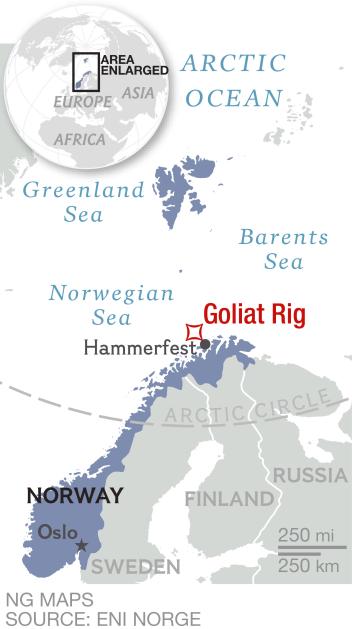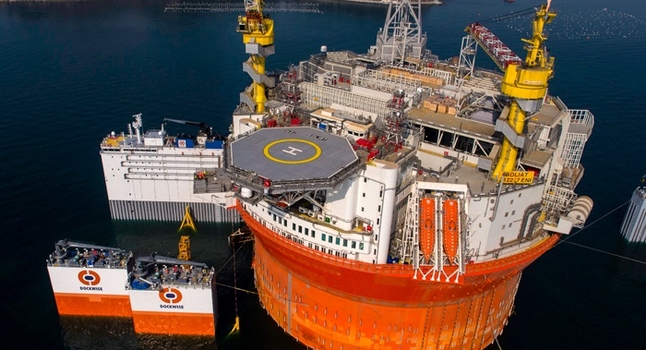April 28, 2015
What's orange, white, and big all over—and a potential harbinger of big changes in the Arctic if not the whole planet? The answer is Goliat, a mammoth, beer-glass-shaped, floating oil platform that’s set to become the northernmost in the world. Last week the 65,000-ton rig arrived for commissioning near the remote Norwegian town of Hammerfest.
 It had ridden piggyback all the way from a South Korean shipyard, more than 15,000 miles, aboard the world's largest heavy lift vessel, the Dockwise Vanguard.
It had ridden piggyback all the way from a South Korean shipyard, more than 15,000 miles, aboard the world's largest heavy lift vessel, the Dockwise Vanguard.
This summer Goliat, which belongs to the Italian oil company Eni Norge and to Norway’s own Statoil, will be towed 53 miles (85 kilometers) northwest to its permanent mooring, near where the Norwegian Sea meets the Barents Sea. At latitude 71.3 north, it will be 140 miles closer to the pole than Russia's Prirazlomnoye platform in the eastern Pechora Sea—the only other offshore rig currently producing oil in Arctic waters.
Everything about Goliat is huge. At 574 feet tall (175 meters), it's about 16 stories taller than the tallest building in Norway. Its mooring lines are the largest ever made, nearly a meter (three feet) across. It will pump and process up to 100,000 barrels of oil a day from its 11 subsea production wells. Its hold will store nearly a million barrels of oil, which will then be shuttled to shore by three brand new tankers.
Goliat arrived two years late and, at $5.5 billion so far, roughly $1.3 billion over budget. Whether Eni and Statoil, which owns 35 percent of the project, will ever make a profit on the platform is not clear.
The reserves in the Goliat field are estimated at 174 million barrels, and according to one industry analyst, oil prices would have to average $95 a barrel during the projected 15-year-life of the Goliat field for the companies to break even. The price of oil plummeted below $40 a barrel earlier this year. It remains below $70 this week.
 Environmentalists hope the high cost of operating in the region will dissuade other companies from following in Eni's and Statoil’s footsteps. Last week Greenpeace activists boarded a Shell drill rig in the mid-Pacific as it was bound for Seattle and ultimately for Alaska's Chukchi Sea, where it is scheduled to begin exploratory drilling this summer.
Environmentalists hope the high cost of operating in the region will dissuade other companies from following in Eni's and Statoil’s footsteps. Last week Greenpeace activists boarded a Shell drill rig in the mid-Pacific as it was bound for Seattle and ultimately for Alaska's Chukchi Sea, where it is scheduled to begin exploratory drilling this summer.
Frederic Hauge, president of the Norway-based Bellona Institute, says “the rush for oil in the Arctic” is leading oil companies to neglect existing fields. “Before you drill in the Arctic, you should empty the reservoir in the North Sea,” he says. Several companies have lately shelved projects and laid off workers in the North Sea because of low oil prices.
The Goliat field lies in what Eni officials describe as "the manageable Arctic," with a relatively shallow, low pressure reservoir that remains ice-free year-round, thanks to the warming influence of the Gulf Stream. They envision a chain of Goliats at the top of the world, taking deep drafts of Arctic oil, as global warming melts more of the region.
To reduce its own carbon emissions, Goliat will be partially powered by the world's longest AC electric cable, which will plug into Norway's electric grid.
But the bigger problem is the emissions from burning the oil the rig produces. Research recently published in Nature estimated that in order to have even a 50/50 chance of keeping the global temperature increase to a relatively manageable two degrees Celsius (3.6 degrees Fahrenheit), all the hydrocarbons in the Arctic would have to remain in the ground.